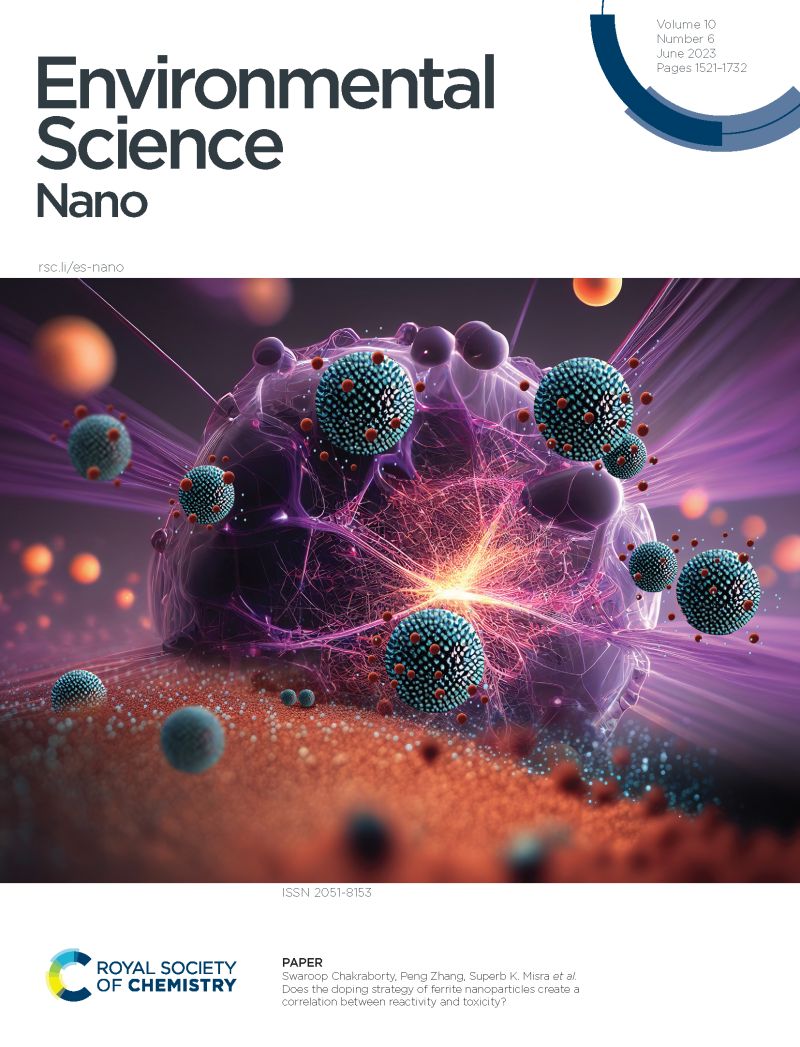Tissue-specific Responses of Duckweed to Cadmium Stress under Nanoplastic Co-exposure: Differential Accumulation and Toxicity in Roots and Fronds
IF 5.8
2区 环境科学与生态学
Q1 CHEMISTRY, MULTIDISCIPLINARY
引用次数: 0
Abstract
Nanoplastics (NPs), characterized by their small size and widespread presence, are known to interact with other contaminants, potentially modifying their environmental behavior and biological impacts. Herein, we explored the response of duckweed (Spirodela polyrhiza) to Cd (0, 0.01, 0.1, 1 mg/L) stress upon co-exposure to polystyrene NPs (PS-NPs) (0, 0.1, 1, 10 mg/L). Cd exhibits significantly higher toxicity to the duckweed compared to PS-NPs. Notably, the presence of PS-NPs exacerbates Cd toxicity in the roots, while mitigating its adverse effects on the fronds. In-situ analyses using Laser Ablation Inductively Coupled Plasma Mass Spectrometry and Confocal Laser Scanning Microscopy demonstrate that PS-NPs enhance Cd accumulation in the root tips (by up to 19.3%) but reduce its presence in the basal root regions and further translocation to the fronds by up to 26.8%. Metabolomics and gene expression analyses further indicate that PS-NPs elevate organic acid contents and modify gene expressions in duckweed against exogenous Cd stress, thereby inhibiting the root-to-frond translocation of Cd. The findings enhance our comprehension of the complex interactions between NPs and environmental pollutants in aquatic flora.纳米塑料共暴露下浮萍对镉胁迫的组织特异性反应:根和叶的差异积累和毒性
纳米塑料(NPs)以其小尺寸和广泛存在为特征,已知与其他污染物相互作用,可能改变其环境行为和生物影响。在此,我们研究了浮萍(Spirodela polyrhiza)在共暴露于聚苯乙烯NPs (PS-NPs)(0、0.1、1、10 mg/L)时对Cd(0、0.01、0.1、1 mg/L)胁迫的响应。Cd对浮萍的毒性明显高于PS-NPs。值得注意的是,PS-NPs的存在加剧了镉对根系的毒性,同时减轻了其对叶片的不良影响。利用激光烧蚀电感耦合等离子体质谱和共聚焦激光扫描显微镜的原位分析表明,PS-NPs增加了Cd在根尖的积累(最多19.3%),但减少了Cd在基根区域的存在,并进一步向叶片转运,减少了26.8%。代谢组学和基因表达分析进一步表明,PS-NPs提高了浮萍体内有机酸含量,并改变了外源Cd胁迫下浮萍体内的基因表达,从而抑制了Cd从根到叶的转运。这一研究结果进一步加深了我们对水生植物群中ps与环境污染物之间复杂相互作用的理解。
本文章由计算机程序翻译,如有差异,请以英文原文为准。
求助全文
约1分钟内获得全文
求助全文
来源期刊

Environmental Science: Nano
CHEMISTRY, MULTIDISCIPLINARY-ENVIRONMENTAL SCIENCES
CiteScore
12.20
自引率
5.50%
发文量
290
审稿时长
2.1 months
期刊介绍:
Environmental Science: Nano serves as a comprehensive and high-impact peer-reviewed source of information on the design and demonstration of engineered nanomaterials for environment-based applications. It also covers the interactions between engineered, natural, and incidental nanomaterials with biological and environmental systems. This scope includes, but is not limited to, the following topic areas:
Novel nanomaterial-based applications for water, air, soil, food, and energy sustainability
Nanomaterial interactions with biological systems and nanotoxicology
Environmental fate, reactivity, and transformations of nanoscale materials
Nanoscale processes in the environment
Sustainable nanotechnology including rational nanomaterial design, life cycle assessment, risk/benefit analysis
 求助内容:
求助内容: 应助结果提醒方式:
应助结果提醒方式:


